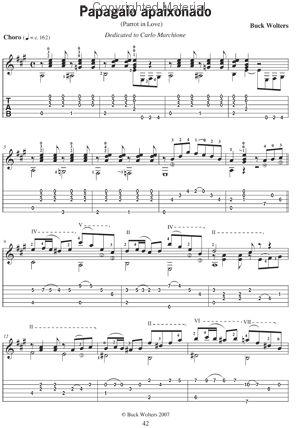POPULAR GUITAR STYLES SAMBA & BOSSA NOVA, Burkhard Buck Wolters. BOOK WITH CD & GUITAR TABLATURE
LIBRO DI MUSICA PER CHITARRA CON CD.
SPARTITI PER CHITARRA FINGERSTYLE CON:
PENTAGRAMMA E TABLATURE.
Product Description:
Popular Guitar Styles: Samba and Bossa Nova reflects recent popular Brazilian styles as played with classical or fingerstyle technique. This collection of original pieces will delight both listeners and guitarists who want to add samba and bossa nova music to their repertoire. The playing level is intermediate to advance. Left-hand difficulties like barrés and stretches are minimized to make it easy to make the music groove. Written in standard notation and tablature.
Caminho do coracao (Afoxe) Buck Wolters (Path of the Heart) Caminho do coração
Copacabenny (Samba) Buck Wolters
Giro do gaviao (Partido Alto) Buck Wolters (Falcon's Cicle) Giro do gavião
Jobinho (Bossa Nova) Buck Wolters
Papagaio apaixonado (Choro) Buck Wolters, dedicato a Carlo Marchione (Parrot in love)
Illustrazioni di: Petra Hartmann
Ingenniere Audio della registrazione del CD: Marcus Pipke
Brazil is one of the musical melting-pots of the world. The mixture of African and the native Indian culture,
a highly developed European classical tradition, joyful Caribbean and melancholic Latin American mood, the
expressive freedom and complex harmony of jazz characterizing altogether the music of this extraordinary country.
Within the limited space of this book I just have chosen five styles from this extensive range of music. I hope
you will enjoy these five Brazilian compositions of mine. The styles that they represent are explained briefly in
the following. Buck Wolters
Caminho do coracao (Afoxe)
Also known as Ljexa, Afoxe is originally a dance and singing style performed at religious processions in honor
of Oxum (goddess of love), sung in Yoruba, a language of African origin. Afoxe is also a word for a special shaker
(Xequere).
Copacabenny (Samba)
Originally Samba was a collective name for many dance-styles that where brought to Brazil by African slaves.
The word Samba comes from "Semba" which means "belly-dance". Because the slaves got their feet and hands
tied they could only dance with their bellies. Also The Maxixe (known as "Brazilian Tango") which was the first
original Brazilian urban dance in the late 19th century contributed to the development of Samba.
Copacabenny is dedicated to my dear friend and drummer Benny Mokross.
Jobinho (Bossa Nova)
Bossa Nova (translated: "New Wave") had it beginnings in the late 1950th and can be seen as a mixture of
Samba and Cool Jazz. One can say, that Bossa Nova is a "cooled down" Samba, played with a smoother and softer
attitude. Samba and Bossa Nova share the same rhythmic basic-pattern, the Samba- or Bossa-Nova-Clave:
Jobinho is dedicated to Antonio Carlos Jobim (1927-1994), who made Bossa Nova popular all over the
world.
Giro do gaviao (Partido Alto)
Partido Alto is a style with stronger pop- and jazz influences. It is mostly played in the big cities of eastern
Brazil, normally performed by electric bands. Of all styles that are presented here it is the most modem. Partido
Alto is also based on the clave mentioned above.
Papagaio apaixonado (Choro)
Choro came into being from a mixture of Habanera, Polka, and African dance styles in the 2nd half of the
19th century. It is mainly instrumental music, which demands much virtuosity from the players, because it is to be
played in a constant rush of eighths, or sixteenths. Like in Jazz, the players improvise on the form, and harmonic
structure of the Choro. Often they improvise collectively as in a competition. Probably the word Choro comes
from "chorar" which means "crying" or from the African dance Xolo.
Papagaio apaixonado is dedicated to my dear friend Carlo Marchione, one of the world greatest classical guitarists.





